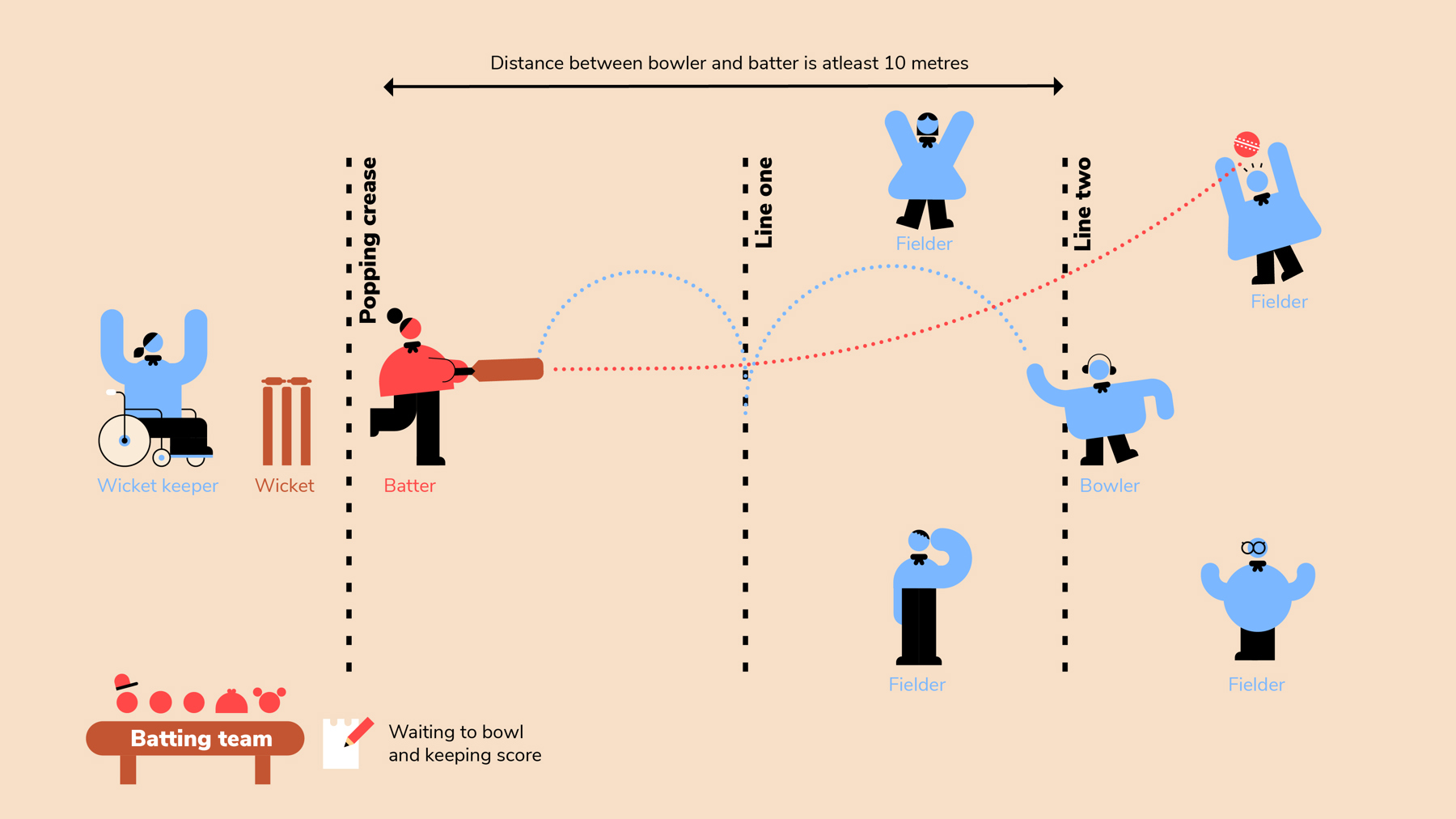Kwik cricket crew
You’ll need
- Small plastic balls
- Masking tape
- Pens or pencils
- A4 paper
- Light cricket bat
- Wicket

Before you begin
- Decide where you’ll play - kwik cricket is best played outdoors, but you could also use a large indoor space.
- Spend a bit of time getting familiar with the rules - it might look like a lot, but it’s quite simple once you get the hang of it.
- Ask if any parents or carers play cricket, or get in touch with a local club or university society. They may be able to help lead the activity, or may have equipment you could borrow.
- Set up the game using the court diagram above. You could use masking tape, cones, or chalk.
Get ready to play
- The person leading the game should introduce kwik cricket. It’s a fun version of cricket that lets everyone practice their skills. There are several ways to play – these instructions are for a simplified version of ‘Lord’s Game’.
- Everyone should split into two teams. Kwik cricket teams usually have around five or six players.
You can adjust the number of players, or run a tournament where multiple teams play each other at once.
- One team should bat first, while the other team bowls and fields.
- One player from the batting team should stand in front of the wicket (just in front of the popping crease) holding the bat. They are the batter. The rest of the batting team should stand in a line until it’s their turn to be the batter. They should have the paper and pen as they’ll keep score.
- One player from the fielding team should stand behind the wicket. They’re the wicket keeper. One player from the fielding team should stand at least 10 metres away from the batter, behind line two. They’re the bowler. The rest of the fielding team should spread out around the space.
Play kwik cricket
You may want to run a few quick practice rounds, where everyone gets one turn to bat and the scores don’t count, so everyone gets used to the game before they begin.
- Once everyone’s in position, the bowler should bowl underarm towards the batter. The batter should try to hit the ball. The further they hit the ball, the longer they’ll have to score runs (but they should make sure a fielder can’t catch it).
- If the batter hits the ball while it’s between line one and the popping crease, they score one run (unless they’re caught out – we’ve included a list of how they get ‘out’ below).
- The batter should try to score more runs by running to either line one or line two, and then back to the popping crease. They can keep running back and forth as many times as they like, but they should be careful not to be caught out by the wicket keeper.
Batters score one run each time they make it to line one and back, and two runs each time they make it to line two and back.
- Meanwhile, the rest of the batting team (the line of players waiting to bat) should keep score, with the help of an adult. They could count together out loud. They could also encourage their batter.
- Meanwhile, the fielders should try to catch (or run to and retrieve) the ball. They should decide whether to throw it to the batter or the wicket keeper, depending on what is more likely to get the player’s turn finished quickly (or get them) out.
Remember, we’ve included a list of what gets the player out below.
- Once the ball has made it back to the bowler, the batter’s turn is over. They should join the back of the line of people waiting to bat. If they’re out, they should sit down.
- Each of the bowlers should have the chance to have two turns. If they’re out, they don’t get a second turn.
- The teams should switch, and repeat steps one to six so both teams have had an equal chance to score runs.
- Keep switching roles until everyone’s ready to finish the game. Make sure both teams have the same number of turns batting.
How to catch a batter out
- Any fielder catches the ball before it bounces (or touches the floor).
- A fielder throws the ball to the wicket keeper (and the wicket keeper catches it) while the batter is away from the popping crease trying to score runs.
- The bowler bowls the ball and it hits the wicket (usually because the batter has missed).
- The batter steps on or knocks over their own wicket (including with their bat).
Reflection
This activity was a chance to be active while trying new things. Did everyone enjoy the new game? What did they enjoy learning and practising? People may talk about hitting the ball, running, caching, and throwing - they may also talk about paying attention and keeping their eye on the ball, especially when fielding. Was the game new for everyone, or had anyone played before? If there were more experienced players, did they help by offering advice to the newer players?
When being active by playing a team game such as cricket, people have to work together. Sometimes people had to throw the ball to another player or rely on someone else to help them out. Well done to everyone who tried something new and didn’t give up!
Safety
All activities must be safely managed. You must complete a thorough risk assessment and take appropriate steps to reduce risk. Use the safety checklist to help you plan and risk assess your activity. Always get approval for the activity, and have suitable supervision and an InTouch process.
- Active games
The game area should be free of hazards. Explain the rules of the game clearly and have a clear way to communicate that the game must stop when needed. Take a look at our guidance on running active games safely.
- Contact games and activities
Make sure everyone understands what contact is acceptable, and monitor contact throughout the activity.
- Add or remove rules. For example, you could ask the fielders to rotate every time the batter changes, so they each get a turn at bowling and wicket keeping. You could also introduce rules as you go, for example, that a batter is out when the fielder catches the ball.
- You could change the size and height of the wicket, or the distance between the lines (as long as the bowler remains at least 10 metres away from the batter).
Players can play from a seated position. They could score runs in an alternative way, for example, moving around the stumps. Players can also play with larger balls or different bats (for example, using with tennis rackets). More information can be found here.
All Scout activities should be inclusive and accessible.
You could hold a tournament, perhaps even with another group.
Anyone who’s familiar with the game could help explain the rules or demonstrate, or they could help umpire.

